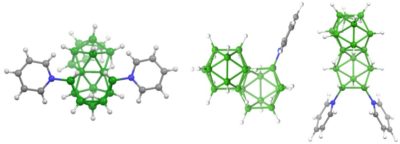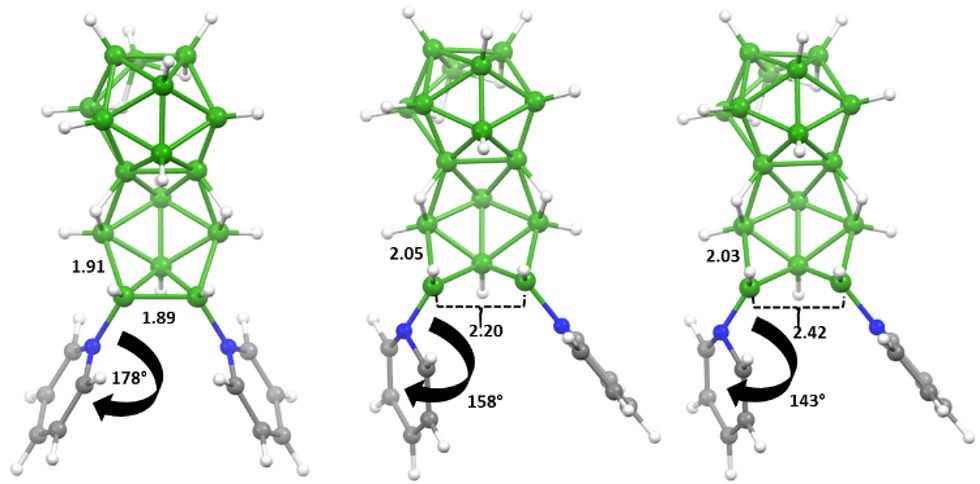Reaction of the laser borane anti-B18H22 with pyridine in neutral solvents gives sparingly soluble B16H18-3′,8′-Py2 as the major product (ca. 53 %) and B18H20-6′,9′-Py2 (ca. 15 %) as the minor product, with small quantities of B18H20-8′-Py (ca. 1 %) also being formed. The three new compounds are characterised by single-crystal X-ray diffraction analyses and by multinuclear multiple-resonance NMR spectroscopy. B18H20-6′,9′-Py2 is of ten-vertex nido : ten-vertex arachno two-atoms-in-common architecture, long postulated for a species with borons-only cluster constitution, but previously elusive. B16H18-3′,8′-Py2 is of unprecedented ten-vertex nido : eight-vertex arachno two-atoms-in-common architecture. The single-crystal X-ray diffraction analysis for the picoline derivative B16H18(NC5H4Me)2, similarly obtained, is also presented. B18H20-8′-Py is also previously unreported but is of known ten-vertex nido : ten-vertex nido two-atoms-in-common architecture of anti configuration, but now with the pyridine ligand positioned differently to other reported examples of B18H20L compounds.  Factors behind the remarkably low solubility of B16H18-3′,8′-Py2 are elucidated in terms of electrostatic potential (ESP) calculations, polarity, and Van-der-Waals complementarities. In view of contemporary developing high interest in the fluorescent properties of macropolyhedral boron-containing species, a detailed assessment of the photophysical characteristics of B16H18-3′,8′-Py2 and B18H20-8′-Py is also presented. In contrast to the thermochromic fluorescence of B18H20-6′,9′-Py2 (from 620 nm brick-red at room-temperature to 585 nm yellow at 8 K, quantum yield 0.15), compound B16H18-3′,8′-Py2 is only weakly phosphorescent in the yellow region (590 nm, quantum yield 0.01), whereas compound B18H20-8′-Py exhibits no luminescence. The far more photoactive nature of B18H20-6′,9′-Py2 is associated with S1 excited-state minima structures that differ from each other only by the relative rotational positions of the pyridine substituents on its disubstituted ten-vertex {arachno-B10Py2}-subcluster. The wavelength and relative intensity of fluorescence from these structures depends on the rotational positions of the pyridine ligands, which in turn are influenced by temperature and/or rotational inhibition in the solid-state.
Factors behind the remarkably low solubility of B16H18-3′,8′-Py2 are elucidated in terms of electrostatic potential (ESP) calculations, polarity, and Van-der-Waals complementarities. In view of contemporary developing high interest in the fluorescent properties of macropolyhedral boron-containing species, a detailed assessment of the photophysical characteristics of B16H18-3′,8′-Py2 and B18H20-8′-Py is also presented. In contrast to the thermochromic fluorescence of B18H20-6′,9′-Py2 (from 620 nm brick-red at room-temperature to 585 nm yellow at 8 K, quantum yield 0.15), compound B16H18-3′,8′-Py2 is only weakly phosphorescent in the yellow region (590 nm, quantum yield 0.01), whereas compound B18H20-8′-Py exhibits no luminescence. The far more photoactive nature of B18H20-6′,9′-Py2 is associated with S1 excited-state minima structures that differ from each other only by the relative rotational positions of the pyridine substituents on its disubstituted ten-vertex {arachno-B10Py2}-subcluster. The wavelength and relative intensity of fluorescence from these structures depends on the rotational positions of the pyridine ligands, which in turn are influenced by temperature and/or rotational inhibition in the solid-state.

